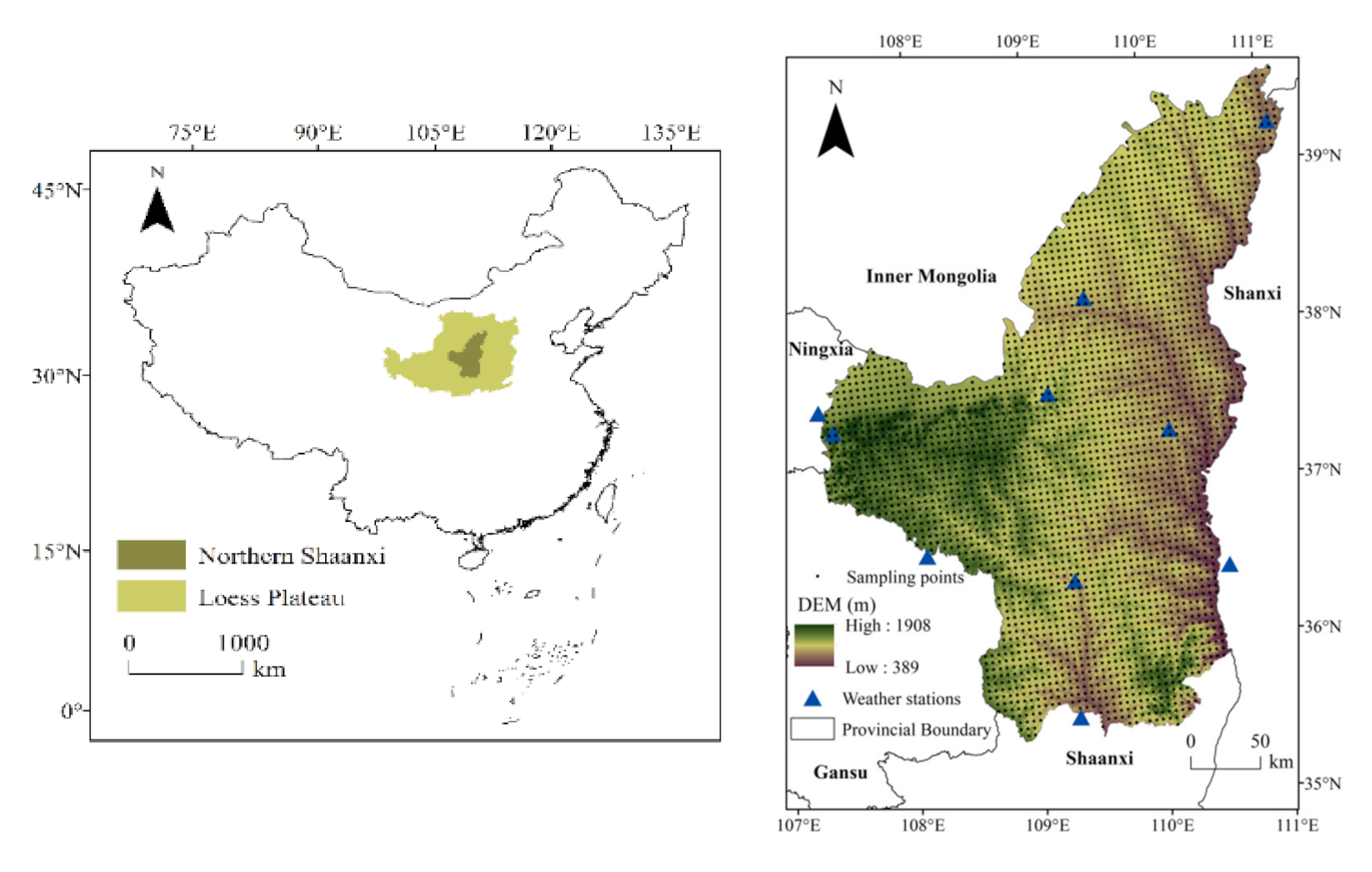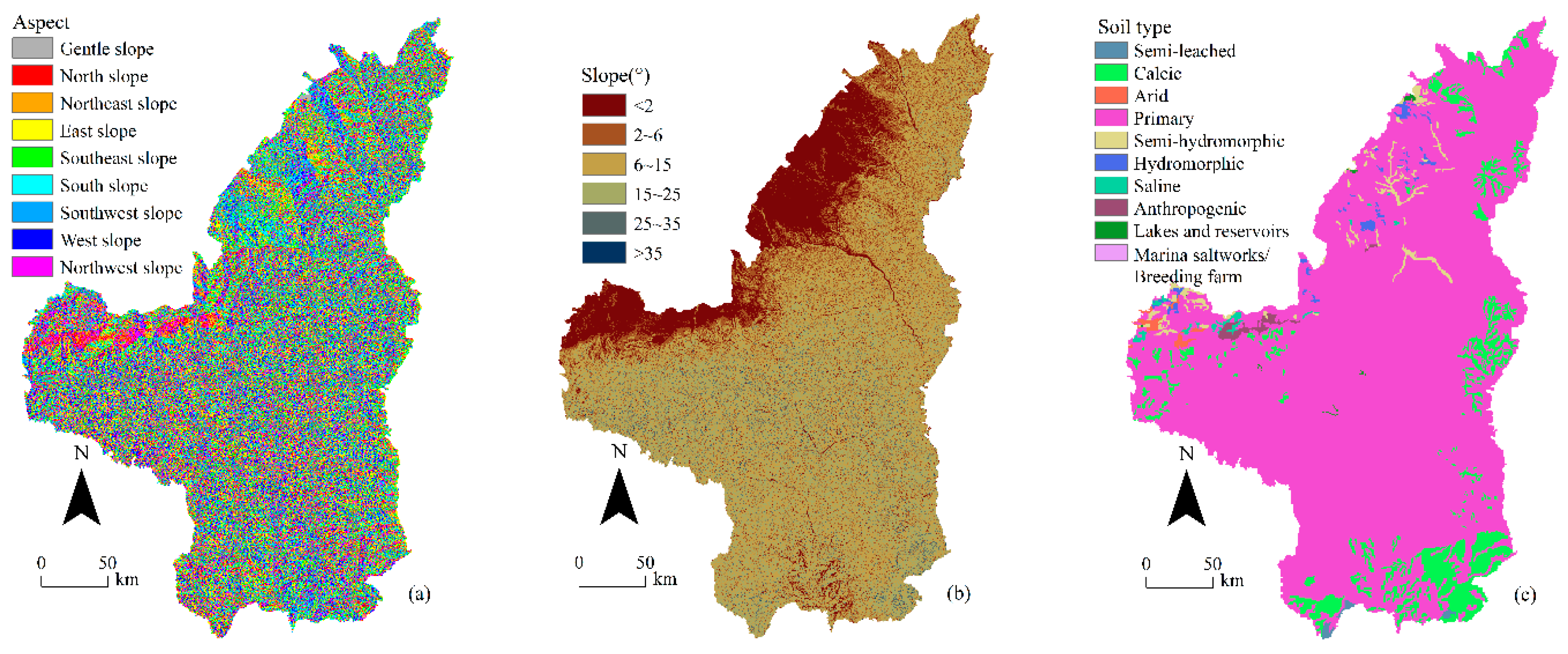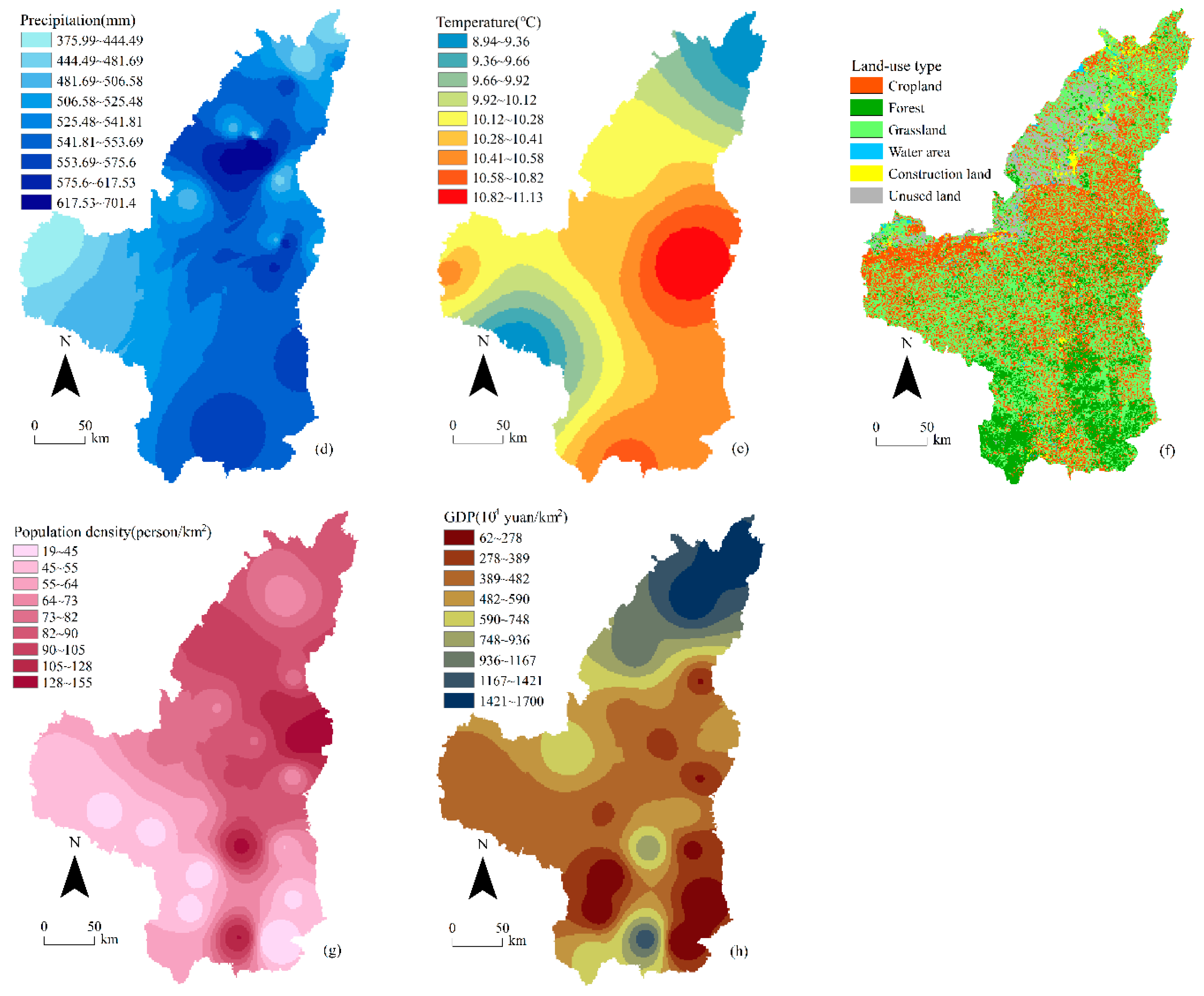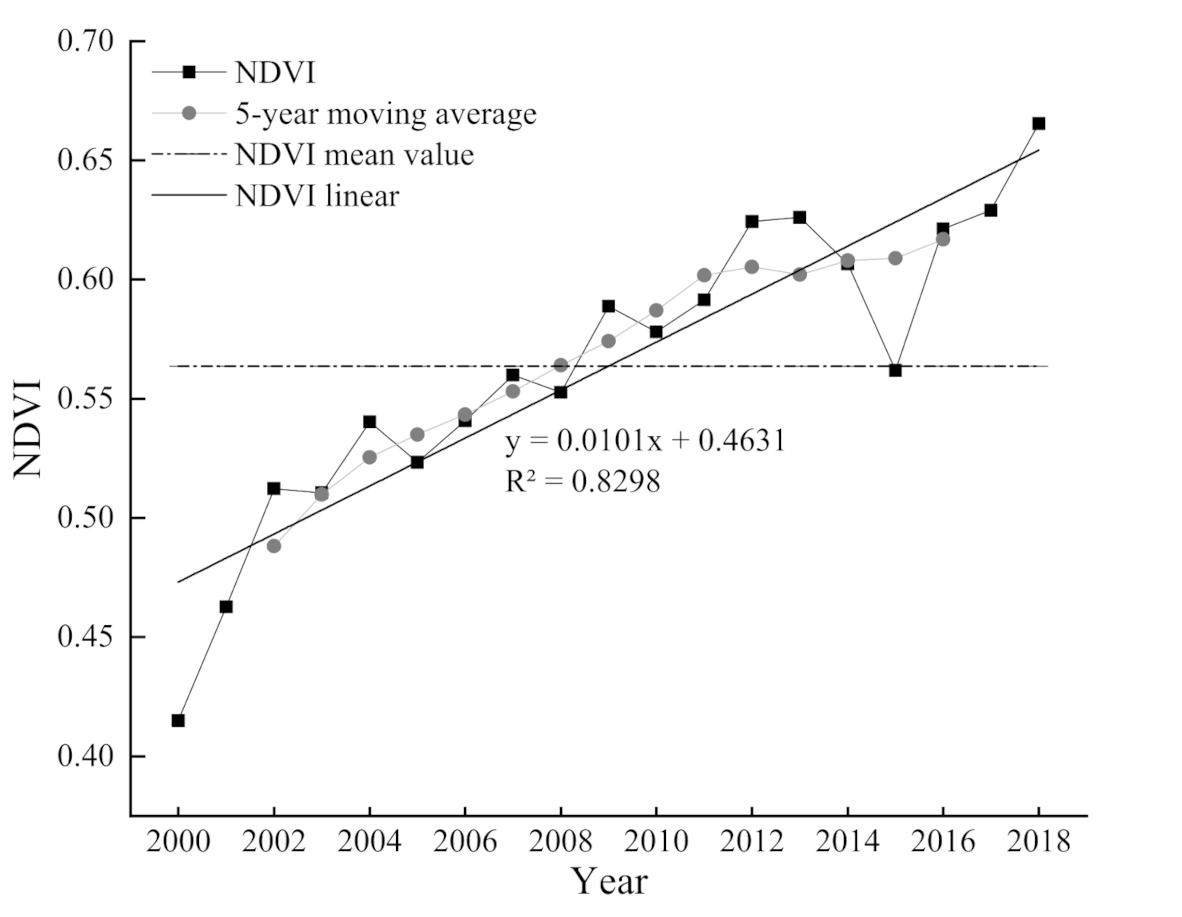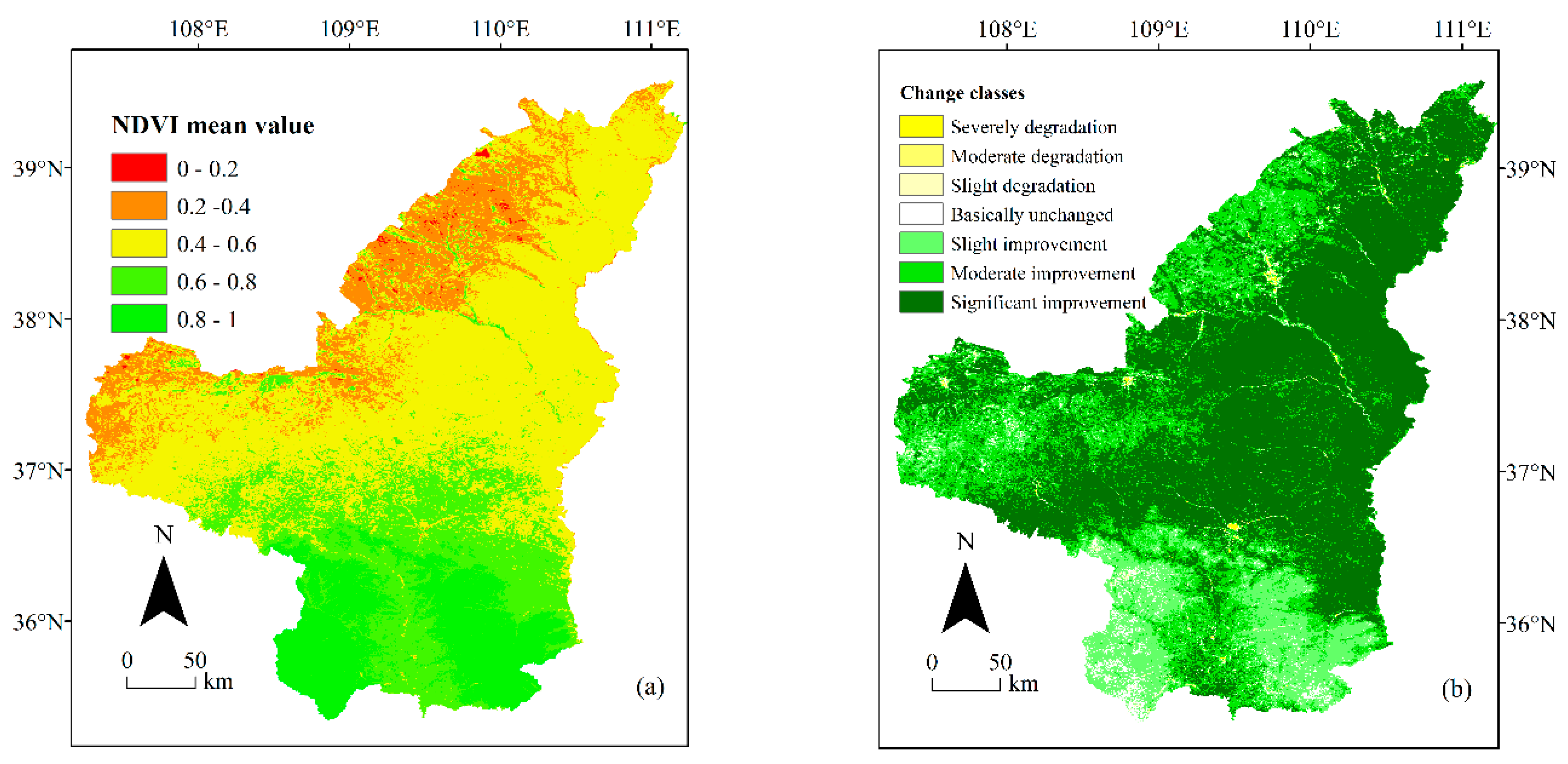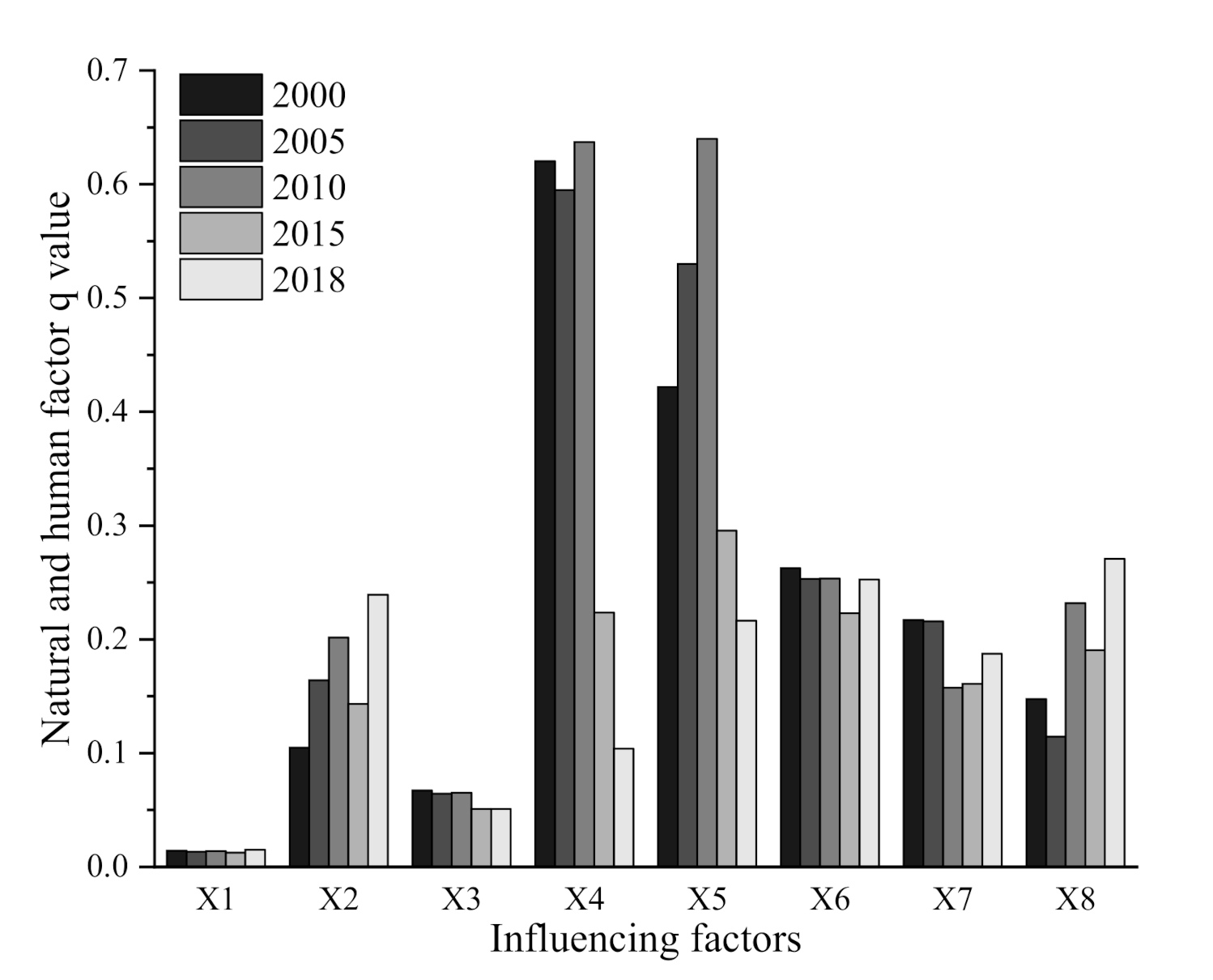1. Introduction
Vegetation is an important component of ecosystems that connects the atmosphere, soil, and hydrosphere [
1]. It is also a sensitive factor that directly reflects changes in the ecological environment. As an important part of terrestrial ecosystems, vegetation provides ecological services and maintains the functions of terrestrial ecosystems [
2]. Vegetation is sensitive to changes in the natural environment and human activities, reflecting the impacts of climate change and human activities in a short time period [
3,
4]. Therefore, comprehensive studies on long-term vegetation changes are of great significance to better understand the sensitivity of vegetation to changes in the natural environment. At the same time, it has important guiding significance to the management of natural resources and the formulation of strategies [
5]. The Normalized Difference Vegetation Index (NDVI), as an important index reflecting the study of vegetation growth and spatio-temporal change, is closely related to vegetation coverage, patterns, biomass, and photosynthesis, and is also a vital indicator for monitoring land degradation [
6]. Therefore, most scholars have extensively used NDVI to study global or regional vegetation cover changes and the driving forces [
7,
8,
9].
The influencing factors of dynamic changes in vegetation have been studied by many scholars. In past studies, satellite remote sensing has provided a reproducible means of monitoring vegetation cover changes at different space and time scales [
10]. Climate change and human activities are the main factors affecting changes in vegetation cover. For example, the climate on the global scale of ENSO has global influences, especially in southern and eastern Africa, eastern Australia, and northeast Asia [
11,
12]. Among the climatic factors affecting vegetation cover in the Northern Hemisphere, temperature was identified as the key factor affecting high-latitude vegetation, and solar radiation corresponded to the vegetation trend in eastern China [
13]. Studies on the driving forces of vegetation in typical regions in China focus on ecologically fragile areas, such as the Loess Plateau, the Tibetan Plateau, and the arid areas of northwest China [
14,
15,
16]. These studies have shown strong correlations between vegetation cover changes and precipitation and temperature. Other natural factors, such as topographic factors, impact vegetation formation and vegetation cover, among which slope and aspect can affect regional vegetation humidity, sunshine radiation, and temperature [
17,
18,
19]. Nowadays, with the intervention of human activities on the natural environment, influences on the spatial change of vegetation cover and vegetation productivity also tend to increase [
20]. Political and socio-economic reforms, exponential population growth, and urbanization have accelerated the decline in ecosystem function. Land use involves the management and transformation of the natural environment into residential areas, such as cultivated land, pastures, and artificial forest. Therefore, land-use change is considered the most direct and comprehensive indicator of human activities, and is the main driving factor for long-term vegetation change in China [
21,
22]. Exploring the relationship between land-use and vegetation changes can effectively reveal the impact of human activities on vegetation growth. A number of positive human interventions, particularly through ecological restoration projects to reduce the development of land degradation, have improved human well-being from socioeconomic and ecological perspectives [
23,
24,
25]. Moreover, China’s urbanization process will not necessarily lead to large-scale vegetation degradation, and the development of marginal areas outside the urban core should be avoided as much as possible to effectively alleviate vegetation degradation [
26]. Studying the temporal and spatial variation of vegetation cover and conducting coupling analysis of natural and human activity factors can enhance ecological sustainability and reduce the limitations caused by the influence of only one factor.
Northern Shaanxi is located in the hilly and gully region of the Loess Plateau. It has an arid climate and fragile ecology, and is also the key area to implement the project of returning cultivated land to forest and grassland [
27,
28]. Drought is expected to become more frequent and severe in the 21st century due to both natural factors and human activities [
29,
30,
31]. At present, the warming and drying of the climate and the increase of extreme weather caused by global warming increase the risk to the ecological environment. Consequently, it is of practical significance to analyze the vegetation cover and driving forces in Northern Shaanxi to investigate this current trend. There have been some research achievements related to the change in vegetation cover on the Loess Plateau in Northern Shaanxi, which have been more concentrated in the 10 years prior to and after the implementation of the returning farmland to forest project process. Most such studies focus on the interannual impact of human activities or natural environmental factors on vegetation cover changes [
32,
33]. According to previous studies, in the present study, slope, aspect, and soil type were selected as surface factors, precipitation and temperature were selected as climate factors, and land-use type, gross domestic product (GDP), and population density were selected as human factors.
Linear, trend, and correlation analyses methods were mostly used to qualitatively analyze the spatio-temporal changes in vegetation cover in previous studies [
34,
35,
36], while the geographical detector model can detect numerical and qualitative data and effectively identify spatial differentiation of vegetation [
37,
38]. As a powerful tool for driving force and factor analyses, a geographical detector is able to quantify the driving force and the influence of its interaction in a robust and direct manner, and does not have to strictly follow the assumptions of traditional statistical methods [
39,
40,
41]. Thus, this approach has been successfully used to quantify the impact of driving factors on vegetation change and may be an effective tool for uncovering the causes of vegetation changes in terrestrial ecosystems. Through this model, this study investigated the spatial differentiation of vegetation and quantified and calculated the influence of various natural and human factors on the spatial distribution of vegetation as well as the types and ranges suitable for vegetation growth. It provides a scientific basis for promoting soil and water conservation, vegetation, and ecological restoration in Northern Shaanxi.
5. Conclusions
Northern Shaanxi is a key area for China’s ecological project of returning cultivated land to forest. Since the project was implemented in 1999, vegetation has significantly improved. Human activities have a positive impact on the ecological environment that cannot be ignored. This study involved analyses of the spatiotemporal differentiation of NDVI during 2000–2018 to explore the mechanism of the effects of natural factors and human activities on the vegetation distribution. The spatial distribution of vegetation was influenced by both natural factors and human activities. Compared with natural factors, human activities have had a more significant impact on vegetation restoration in recent years.
The Loess Plateau in Northern Shaanxi is an important ecological area for soil and water conservation. In this study, the spatial distribution characteristics and variation trend of NDVI in Northern Shaanxi were analyzed using the trend analysis method. Meanwhile, based on the geographic detector model, the influence mechanisms of eight natural and human factors on vegetation NDVI in Northern Shaanxi were analyzed, and the influences and interactive influences of each factor on vegetation were summarized. The spatial distribution characteristics of NDVI in Northern Shaanxi were high in the south and low in the north, among which the high-grade vegetation was distributed in the southwest and southeast, and the low vegetation coverage was mainly located in the northwest. Vegetation tended to improve significantly between 2000–2018. Natural and human factors had common influences on vegetation in Northern Shaanxi. Among them, GDP, land-use type, slope, and temperature had the greatest influences on vegetation. Eight natural and human factors had interactive effects on the NDVI, and the interactive effects between the factors had a mutual or nonlinear enhancement relationship on the spatial distribution of vegetation, and there were no independent relationships. The geographic detector revealed the most suitable range or type of vegetation for each factor, which is helpful for the local government to intervene in vegetation changes within a favorable range and mitigate the negative impact brought by human development. It can provide a reference for promoting vegetation construction and ecological restoration in Northern Shaanxi. Meanwhile, the success of ecological restoration in the region reflects the positive role of environmental policy and the need for adaptive management approaches.
The intricate natural and human factors in Northern Shaanxi have important influences on changes in NDVI. In the selection of indicators, the effects of natural and human factors, and their interactions on vegetation change were considered, while some other conditions were not fully considered. In the future, based on the vegetation NDVI change in vulnerable areas such as Northern Shaanxi, natural and human factors should be selected to analyze and reveal the impacts of driving factors and their interactions on vegetation change as scientifically as possible, so as to effectively guide vegetation restoration and protection in Northern Shaanxi and throughout the Loess Plateau. At the same time, the research area should be expanded and there should be further improvements in the selection and classification of natural and human factors so as to correctly determine the most appropriate range or type of natural and human factors to promote vegetation growth.
